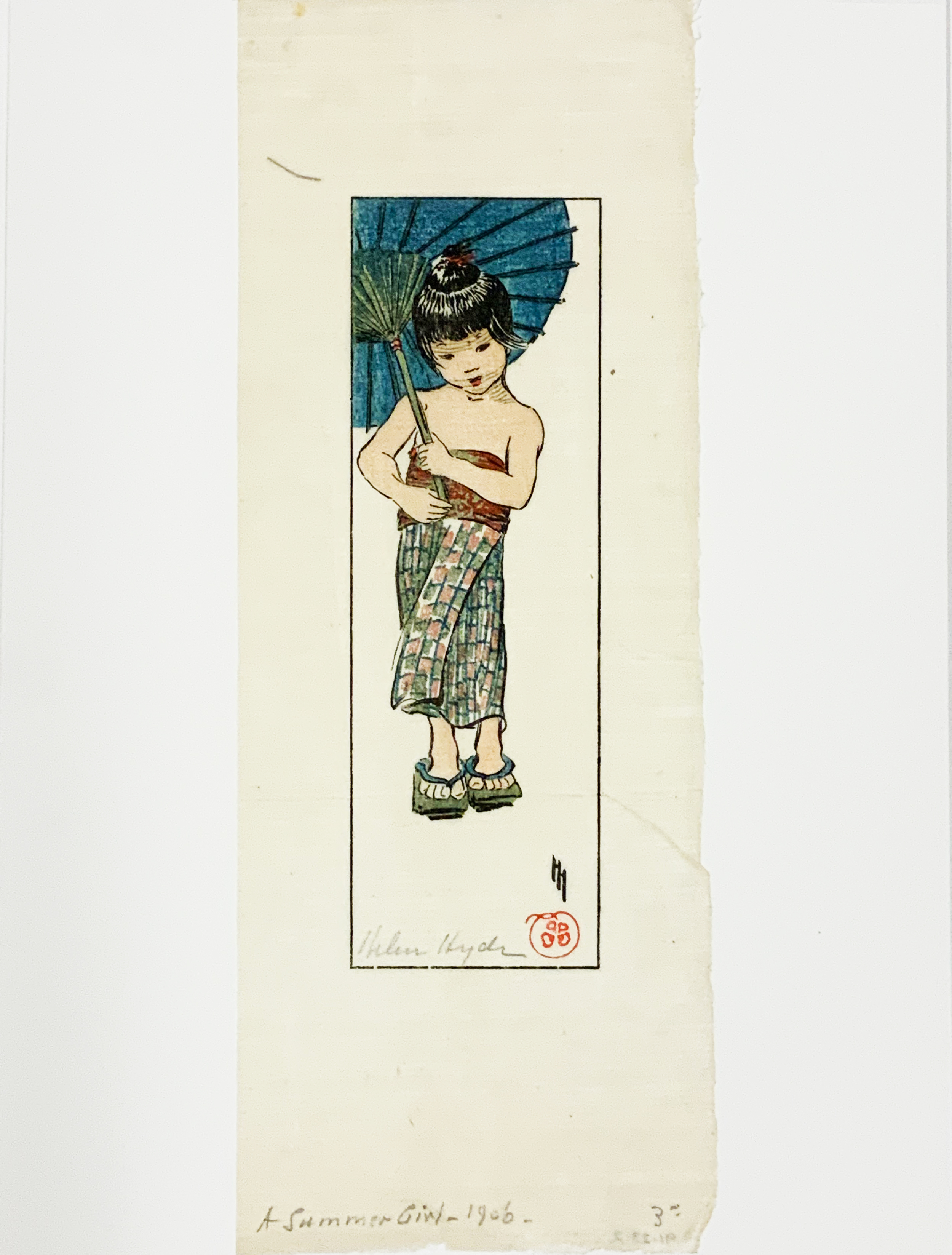
A Summer Girl -Helen Hyde
What are some objects you associate with summer? Perhaps a pair of flip-flop sandals? A parasol to block the sun? A lightweight wrap dress? A bun on top of one’s head? In the 1906 print, A Summer Girl, a young child stands facing the viewer, showcasing some of these objects that conjure thoughts of the season. The girl stands as a solitary figure; her face turned slightly downward as both hands clutch the parasol. Framed by a thin rectangular line, the figure of the girl is accompanied by the artist’s HH monogram and encircled red clover signature in the lower corner. The print, pressed onto tissue-thin paper, was created through the woodblock technique practiced by Californian artist Helen Hyde (1868-1919). Born in Lima, New York, Helen grew up in San Francisco. In 1886, she studied under the Impressionist painter Emil Carlsen at the San Francisco School of Design (San Francisco Art Institute) and in 1888 under Kenyon Cox at the Art Students League in New York. From 1890 through 1894, she continued her education in Berlin and Paris.
During her studies in Paris, Helen was exposed to Japanese woodblock prints called ukiyo-e, or “pictures of the floating world,” which became popular in Europe following Japan’s reopening to trade in 1853. Europe’s fascination with material culture and art from Japan, or Japonism, swept across the art academies and museums, transforming the western art world through new ideas of printing techniques, aesthetic values, and subject matter. Ukiyo-e subjects focused on everyday figures and designs, an element that greatly influenced the Impressionists and Post-Impressionists. American Impressionist Mary Cassatt, who visited the Paris 1890 exhibition of ukiyo-e prints, glorified the nuance of Japanese woodcuts and shortly after adopted the stylistic form of flattening spaces and simplified figures in a series of ten colored etchings. These etchings, coming from an acclaimed and established female artist (at the time 46-years-old) inspired and influenced the art practice of the emerging 22-year-old Helen.
Upon returning to San Francisco in 1894, Helen purchased an etching press and started creating color etchings using a hand-applied technique called a la poupée. In 1899, she traveled to Japan with her etching press. Helen settled in Tokyo, sought out Japanese language lessons and began studying ink painting from Kano Tomonobu (1843-1912) for two years. Later, she moved to the scenic village of Nikko. For the next fifteen years, Helen spent her time between San Francisco and Japan learning and then practicing the traditional woodblock technique.
Similar to William Seltzer Rice’s interest in the woodblock, Helen’s approach to woodblock printmaking came to define her artistic style. However, her approach differs from the typical practice of the western artists of her era, as Helen integrated fully into the context of the culture she depicted.
After learning how to produce the prints in a workshop system, Helen hired Japanese artisans who prepared the blocks and printed them. She maintained the process successfully. Her prints secured her financial independence as she produced over sixty-seven woodcuts, printed in limited editions of 200 copies. She sold the editions for $2 to $15 each.
Slightly different from the practices of her role model Mary Cassatt, who depicted western women dressed in Japanese designs and fabrics, Helen based her images on the mothers and children she encountered in the village of Nikko. These figures were often depicted in both domestic and outdoor spaces, capturing the activities and daily moments of the subjects’ lives. A Summer Girl depicts a casual moment of a child teetering in the clunky sandals that they have yet to grow into. From the cut of the dress to the print of the fabric and the bamboo base of the parasol, A Summer Girl’s visual elements invite the viewer into the world of pre-industrial Japan, the one Helen sought to live in and document. Despite Helen’s full submersion and interest, Japan’s victory over Russia in 1905 marked a shift in the culture. A push for industrialization completely changed the landscape, and by 1914 many of the preindustrial parts of Japan had vanished. Helen, suffering from illness, returned to the United States.
In addition to her work in Japan, Helen visited Mexico and San Francisco (Chinatown), for artistic inspiration. In 1915, her prints were exhibited in the Panama Pacific Exposition in San Francisco. Today, Helen’s work is cared for by the de Young Fine Arts Museums of San Francisco, Museum of Fine Arts Boston, Library of Congress, and the Smithsonian American Art Museum in Washington, D.C.
Source:
“Hyde, Helen (1868-1919) .” in The Johnson Collection, accessed August 5, 2020, https://thejohnsoncollection.org/helen-hyde/.
Hughes, Edan Milton. (1989) “Hyde, Helen". Artists in California 1786-1940, Hughes Publishing Company, ISBN 0-9616112-1-9.
Jensen, Joan "Women Artists of the American West: Helen Hyde, American Printmaker", accessed July 10, 2020, http://www.cla.purdue.edu/waaw/jensen/hyde.html.
Mason & Mason, American Printmakers: Helen Hyde, 1991, p. 52, cat. no. 86 Yokohama Museum of Art, Eyes Towards Asia: Ukiyo-e Artists from Abroad, 1996, p. 39, no. 28
Dr. Charles Cramer and Dr. Kim Grant, "Japonisme," in Smarthistory, June 14, 2020, accessed July 13, 2020, https://smarthistory.org/japonisme/.